The Making of Biblical Separation
The Story behind Ernest Pickering’s Classic Book
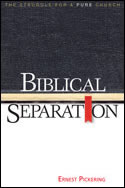 Note: This article is the new foreword to Biblical Separation: The Struggle for a Pure Church, available from Regular Baptist Press.
Note: This article is the new foreword to Biblical Separation: The Struggle for a Pure Church, available from Regular Baptist Press.
When Ernest Pickering wrote Biblical Separation in 1979, fundamentalism had not yet benefited from the dozens of academic studies that would be produced in the 1980s and ’90s. Most fundamentalist leaders were at least mildly peeved about the public perception of the movement, believing that media attention was often dismissive and inaccurate. And despite their historic suspicion of scholarly research, fundamentalists were oddly hurt when academic studies seemed to ignore their core theological values. For fundamentalists, the 1970s was a period of resurgence in the popular conscience, but not a period of enhanced understanding.
It had been this way since the 1925 Scopes trial, when it became popular to parody fundamentalist leaders as “not enough fun, too much damn, too little mental.” Rather than engaging the ideas of fundamentalists, it was easier to relegate them to playing stock characters in Hollywood double features: the Bible-thumping revivalist, the hayseed preacher, the storefront church on the edge of town that was filled with rubes and yokels.
Caricature or not, this was a life that Ernest Pickering knew. He was reared by devout parents, Salvation Army evangelists, who recruited their nine-year-old son to play bass drum in the revivalist band. He was quickly promoted to playing first trumpet, but once he reached high school, Pickering became a street-corner evangelist, “dodging rock throwers and tomato throwers,” as he put it. Leaving home at sixteen, he spent his college years at Bob Jones University.
On the weekends, he and his friends would take the train to dusty southern outposts. Their first stop was usually the tavern, the center of a town’s social life. Convincing the owner to hold a revival meeting, they’d clear off the pool table and lead the crowd in hymn singing before preaching the gospel.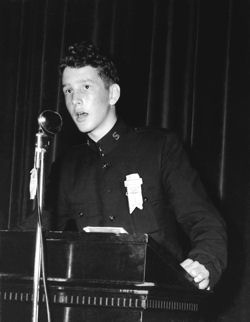 “Don’t go to seminary, Ernie—it will ruin you,” was the advice that Bob Jones Sr. gave Ernest Pickering upon graduation in 1948. But Pickering moved to Dallas, Texas, and enrolled in Dallas Theological Seminary. Old-time revivalists such as Jones were intensely worried that a theological education would spoil a preacher’s evangelistic fervor, but times were changing. Historic fundamentalism probably never deserved the “not enough mental” accusations (its early leaders were generally trained in accredited colleges and seminaries), but such charges became especially spurious with the postwar rush that filled graduate schools with young, bright thinkers such as Pickering.
“Don’t go to seminary, Ernie—it will ruin you,” was the advice that Bob Jones Sr. gave Ernest Pickering upon graduation in 1948. But Pickering moved to Dallas, Texas, and enrolled in Dallas Theological Seminary. Old-time revivalists such as Jones were intensely worried that a theological education would spoil a preacher’s evangelistic fervor, but times were changing. Historic fundamentalism probably never deserved the “not enough mental” accusations (its early leaders were generally trained in accredited colleges and seminaries), but such charges became especially spurious with the postwar rush that filled graduate schools with young, bright thinkers such as Pickering.
He became a student of Lewis Sperry Chafer, who had just completed an eight-volume Systematic Theology, a mature work which showed that premillennialism was more than a cynical response to a mechanized age. Rather, it could be articulated in terms of a fully developed theology that would unite a good deal of fundamentalism around theological ideas (rather than their supposed affinity for antimodern social values).
Chafer had lived a life that didn’t quite fit the fundamentalist profile: he was a pastor who held advanced degrees, a mission board executive who was also a college professor, an academic who still believed firmly in Biblical inerrancy. Following his mentor’s lead, Pickering would also become a pastor, a mission board executive, a college professor, and a college president. And Pickering would also come to write a book that became the standard defense of fundamentalist ideas.
The issue of ecclesiastical separation was an often-discussed topic during Pickering’s seminary years. No one questioned that many denominations were filled with modernists who openly denied basic truths of the Bible, but what to do about it was hotly debated. Should we come out or stay in? Is it better to stay within an increasingly apostate church denomination, or should we withdraw and start over? Chafer, having suffered his own heartaches within a Presbyterian denomination overrun by liberals, had qualms about staying in—but he was also suspicious of those who sought to leave.
“The problem with separatist groups,” Chafer advised his students, “is that they have decreed that the only way to deal with modernism is to sacrifice your influence by getting out.” Chafer offered his students the same solution he had heard as a young man: he advocated expository preaching as the primary method for combating apostasy.
“Never descend to mere controversy,” C. I. Scofield had said to Chafer in 1921. “You have no time or strength for that. Give out the positive Word. Nothing can stand before it.”
Admirable as it was, the Scofield and Chafer ideal of positive expository preaching underwent an ironic twist as Chafer’s students began ministering. The process of preaching through passages of Scripture led many of them to conclude that not every part of the Bible was positive. In fact, expository preaching led many of the young Dallas graduates to conclude that the correct response to apostasy was separation.
This was Ernest Pickering’s journey. He began as a street-corner preacher for the Salvation Army, was ordained a Southern Baptist, and was then trained by nondenominational fundamentalists. In his early ministry he affiliated with a nondenominational group; then a Conservative Baptist seminary; then the General Association of Regular Baptist Churches. He knew and lived the personal cost of ecclesiastical separation—the misplaced accusations, the strained friendships, the tense board meetings. With each transition he was confronted with the brewing question that would not go away: What if the modern evangelical church were to be evaluated by its own developing standard of pragmatism? If the “stay in” approach was better than the “come out” approach, why didn’t it work?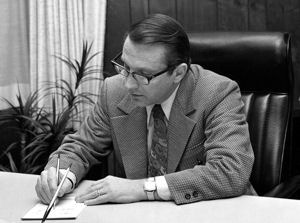 In 1969 Ernest Pickering moved from a pastorate in Kokomo, Indiana, and reentered the academic world. A few months before he became academic dean of Baptist Bible College (Clarks Summit, Pennsylvania), he preached what would become a famous sermon on Biblical separation for the annual meetings of the GARBC. Rising to the presidency of BBC, he would spend the next decade studying the issue at length, writing shorter articles, and patiently answering the pesky questions of seminarians who often wished for a convenient shortcut to Biblical discernment. During this time, Pickering developed a series of lectures that traced the idea of ecclesiastical separation through church history.
In 1969 Ernest Pickering moved from a pastorate in Kokomo, Indiana, and reentered the academic world. A few months before he became academic dean of Baptist Bible College (Clarks Summit, Pennsylvania), he preached what would become a famous sermon on Biblical separation for the annual meetings of the GARBC. Rising to the presidency of BBC, he would spend the next decade studying the issue at length, writing shorter articles, and patiently answering the pesky questions of seminarians who often wished for a convenient shortcut to Biblical discernment. During this time, Pickering developed a series of lectures that traced the idea of ecclesiastical separation through church history.
At one such lecture to a group of college students in 1977, Dr. Pickering suggested that there was no cut-and-dried approach to the practice of Biblical separation. “What we’d like to have is a textbook with handy reference to give us the divine word on all these subjects,” Pickering said. “Well, I don’t have such a textbook. I wish I did sometimes. I can only raise some questions and offer Biblical principles to answer them.”
This lack of a textbook would soon be addressed. Pickering had prepared bundles of notes that he sold at his lectures for fifty cents each. These became the rough chapters for the first edition of Biblical Separation. Major work on the book continued through the spring of 1978, with the kind support of his colleagues at Baptist Bible College. While he was writing, his unresolved tension between preaching and teaching surfaced in a surprising way: He left BBC to become pastor of Emmanuel Baptist Church (Toledo, Ohio), where he finished the final draft of the book. When the first edition rolled off the presses in the spring of 1979, it was already sold out.
The beauty of Biblical Separation is its magisterial scope. Pickering wrote an unapologetic overview precisely at the same time that many academic historians were rejecting the notion of grand, all-encompassing explanations for historical events. Pickering’s history is unified by a theological idea: that every era of church history has been marked by apostasy and the struggle for a pure church.
While Biblical Separation was being released, George Marsden was finishing another history, Fundamentalism and American Culture, tracing the development of the movement through 1925. Marsden wrote from outside the movement but offered many insights—some affirming, some penetrating—regarding the rise of fundamentalism. But the two books were like ships passing in the night. Pickering’s analysis, leaning heavily on historical theology and Bible exposition, described a different side of the movement than Marsden, who emphasized the social forces during America’s transition from agrarian to urban lifestyles. As a result, many scholars continued to miss a key concept: American fundamentalism was more than a product of its time; it was a theological struggle.
The two books ignited a flood of work from both sides of the fence. Academics continued to refine their research about fundamentalism’s relationship to American culture, and theologians continued to refine their beliefs about the nature of the church and the content of the gospel. At times, the conversation between the groups was civil and offered moments of rare insight. Marsden himself later noted how the meaning of the word “fundamentalist” changed after the 1930s: “The change in terminology was gradual; but by the 1960s ‘fundamentalist’ usually meant separatists and no longer included the many conservatives in mainline denominations.”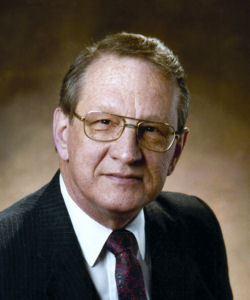 This was the heart of the issue—the crucial theological concept that motivated the developing movement. With the publication of Biblical Separation, Dr. Pickering unwittingly wrote himself into the history of fundamentalism. All who study the movement after him must now interact with his ideas or be left with mere social analysis.
This was the heart of the issue—the crucial theological concept that motivated the developing movement. With the publication of Biblical Separation, Dr. Pickering unwittingly wrote himself into the history of fundamentalism. All who study the movement after him must now interact with his ideas or be left with mere social analysis.
After the publication of Biblical Separation, Pickering absorbed many more ideas as he interacted with a new generation of young preachers—some of whom were raised within fundamentalism and were the sons of its leaders, but who moved to a broader evangelical approach. When they peppered Pickering with questions, they often asked for more Bible exposition about ecclesiastical separation. In response, Pickering continued to write, but these articles and pamphlets did not receive as wide a distribution as his original text.
This was the motivation for offering an updated edition to Biblical Separation. Our goal was not to introduce outside material defending Pickering’s position; rather, we wished to allow Pickering’s view to be explained as completely and clearly as possible by his own later work. Along the way, we have also updated the footnotes, bibliography, and subject index. In certain places where later authors have illuminated Pickering’s ideas, we have suggested additional resources in bracketed footnotes to indicate editorial additions. Minor edits were made to conform to the changing rules of grammar and punctuation. Some details have merited judicious updates: organizational names change, affiliations change, and some who were living in 1979 have now earned a past-tense verb.
We believe those who are familiar with the first edition will be interested to see the effect of Dr. Pickering’s later writings. For instance, Dr. Pickering sometimes expressed impatience with the term “secondary separation,” while continuing to defend the idea of separating from other Christians when necessary. And, his brooding grief over the tragedy of separation will surprise those who speak of “fighting fundamentalists.”
One other detail bears noting: Dr. Pickering’s practical advice about the heart attitudes of a separatist would have saved us a lot of grief, had we listened.
Myron Houghton has contributed chapter 10, “Separation Issues since Ecumenical Evangelism in the 1970s,” in which he brings Dr. Pickering’s history forward to our present era. Publishers often struggle to find the best way to update works that are based on recent historical analysis—which this book is. Dr. Pickering did not believe that the struggle for a pure church would be resolved in his own lifetime; rather, he believed it would continue “until the Head of the church returns.” So we are grateful for this additional chapter, written by a former student of Dr. Pickering, which explores developments since the 1979 edition.
Around the office we accord Biblical Separation a place of high honor. To be sure, every publisher dreams of having a title continuously in print for thirty years—and for small denominational presses such as ours, this is extremely rare. But we consider this book to be more than just a publishing milestone. It is valuable because it addresses a core value that defines and unites those who believe in a pure church. So our work as caretakers of this updated edition has been an honor and labor of love. Soli Deo Gloria.
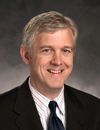 Kevin Mungons is editorial director of publications for Regular Baptist Press (Schaumburg, IL) and managing editor of the Baptist Bulletin. He has previously ministered as an associate pastor and a high school music teacher. He and his wife, Carla, have ten children and live near Chicago. The author is grateful for the assistance of Dawn Jacobs; Lloyd Pickering; Dallas Theological Seminary; Jeff Brodrick of Murphy Memorial Library at Baptist Bible College (Clarks Summit, PA.); Pat Passig of Central Baptist Theological Seminary Library (Plymouth, MN); and Michael Windsor of the Ernest Pickering Library, Central Baptist Theological Seminary (Virginia Beach, VA). Kevin Mungons is editorial director of publications for Regular Baptist Press (Schaumburg, IL) and managing editor of the Baptist Bulletin. He has previously ministered as an associate pastor and a high school music teacher. He and his wife, Carla, have ten children and live near Chicago. The author is grateful for the assistance of Dawn Jacobs; Lloyd Pickering; Dallas Theological Seminary; Jeff Brodrick of Murphy Memorial Library at Baptist Bible College (Clarks Summit, PA.); Pat Passig of Central Baptist Theological Seminary Library (Plymouth, MN); and Michael Windsor of the Ernest Pickering Library, Central Baptist Theological Seminary (Virginia Beach, VA). |
- 77 views


Discussion